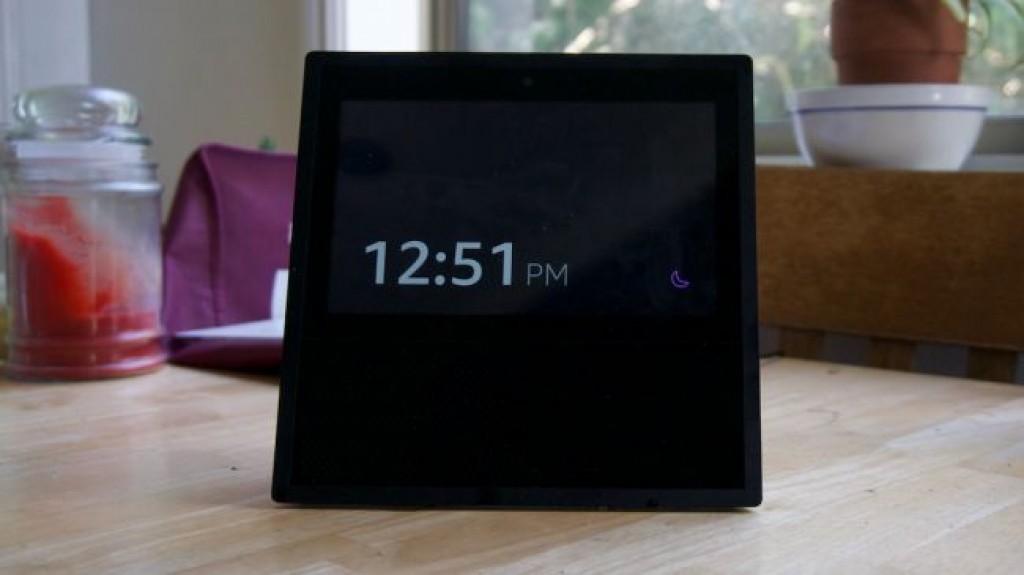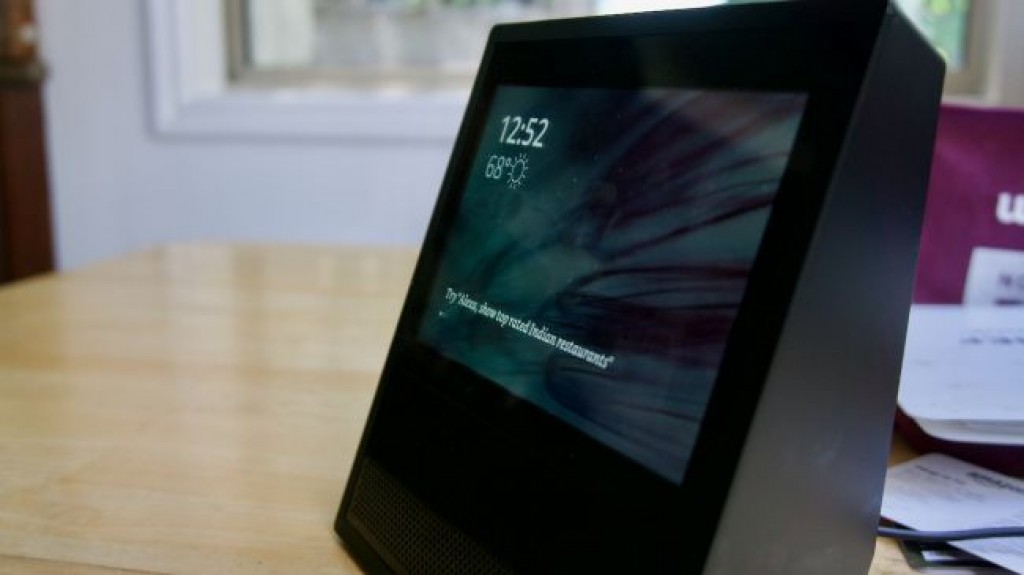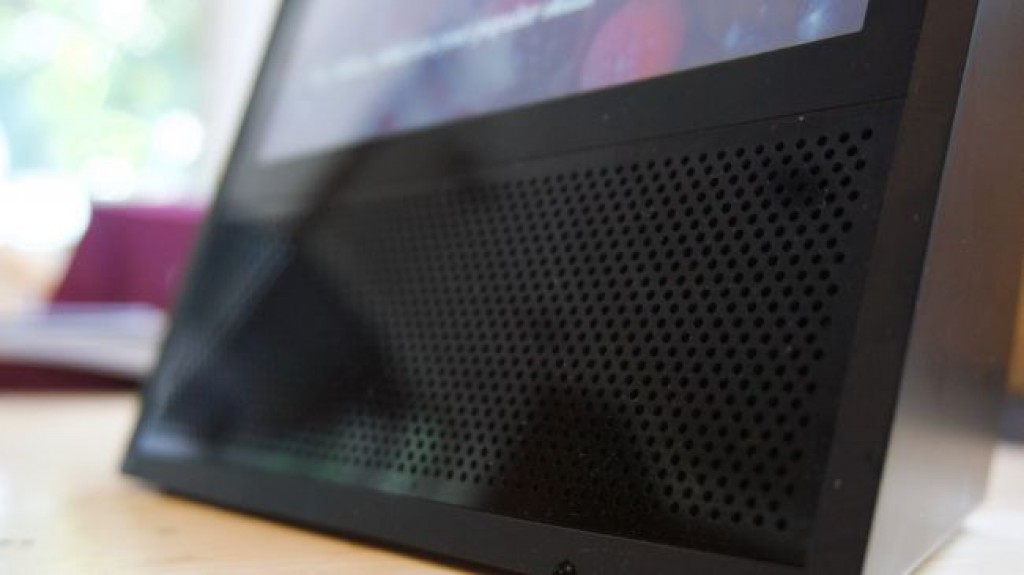
OUR VERDICT
The Echo Show, like the Echo before it, is more of a fun, ancillary device than it is a true necessity. It adds value by combining devices you already have and ones you could buy at a lower price elsewhere – just look at the Amazon Echo Dot, for example. But all-together the Show is a marked improvement on the original Echo, and one that deserves a spot on the kitchen counter, if for no other reason as a gateway to the long-promised smart home.
FOR
- Awesome voice recognition
- Visually rich touchscreen
- Competent smart home hub
AGAINST
- Speaker still sounds shallow
- Video calling is limited
- Alexa needs some schooling
Technology, as you might’ve noticed, moves fast. It seems like the second you fully understand a product – all of its strengths and weaknesses – the company that makes it goes and releases a sequel.
Such is the case with the Amazon Echo, a first-of-its-kind smart speaker that released back in June 2015, and the new Amazon Echo Show, which just released in June of this year.
The Amazon Echo Show is a completely new take on the smart speaker; one that has its own set of challenges, obstacles and benefits.
That new challenge, in case you missed the memo, is the additional 7-inch touchscreen and 5 megapixel camera that will allow you to interact with Alexa, the Amazon Echo Show’s built-in assistant, in wholly novel and unique ways.
Some of those ways will markedly improve your quality of life – you can summon visually rich recipes with just a few words or see lyrics for your favorite songs, for example – while others will undoubtedly frustrate you.
This is a repeat of the huge problem we had with the original Echo: Alexa is smart, but it’s still so limited. Commands that should be relatively simple to parse befuddle the ‘smart’ speaker. Even now, months after launch, things still aren’t where they could be.
Alexa isn’t the perfect assistant but it’s still evolving, and before you judge a book by its first few pages we invite you to take a ride with us as we uncover what it’s like to use the Amazon Echo Show every day for three months.
Design and set-up
- Subtle, svelte design
- 7-inch touchscreen and 5MP camera
- Speaker has been improved, but still not great
- But microphone array is amazing through and through
Unlike the uniquely obelisk-esque Amazon Echo, the Echo Show is made to fit any environment – its subtle black frame can blend into corners of your kitchen, living room or bedroom without attracting any attention to itself.
What gives the Echo Show away is the glowing screen that lights up when you enter the room. The screen usually offers small tips on how to better use Alexa or prompts you to ask it about a trending news story. Ask Alexa to show you the story and not only will the smart speaker read it to you, but it will also display the text so you can follow along.
Should you decide to eschew privacy concerns entirely and keep your Amazon Echo Show in your bedroom, the Show does have a Do Not Disturb function that darkens the screen and allows you to sleep without the Show’s bright light keeping you up.

The 7-inch touchscreen is, well, tiny – especially if you’re the kind of person who spends most of their days lounging in front of 65-inch TVs or gaming on 32-inch monitors. The size of the screen will likely deter you from watching full movies on the Echo Show (though it does have access to Amazon Prime’s catalogue of content if you should choose to watch it) but it’s just large enough for you to see relevant information.
Speaking of ‘just enough’, this is as good a time as any to talk about the front-facing speaker.
One huge problem we had with the original Amazon Echo was that its speaker – you know, the thing that comprised 50% of the product – sounded really subpar compared to the other Bluetooth speakers on the market at the time. For whatever else hasn’t been fixed with Alexa as an artificial intelligence, at least the speaker has been significantly improved: It’s still shallow, harsh and can be underwhelming when challenged face-to-face with another speaker in its weight class but all things considered the speaker here gets the job done.
The magic of the Amazon Echo Show happens with its far-field microphone array that’s located at the top of the speaker, encircling the volume up/down and microphone on/off buttons. It can hear you over the sound of a conversation or your blaring music. Words can be misheard or misinterpreted from time-to-time, but rarely do I feel like it’s the microphone array’s fault. It is, for the time being, Amazon’s real secret sauce.

The setup process, especially for those of us with an Amazon device already in the house, should go smoothly and quickly. Connect the device to the Alexa app on your phone via Wi-Fi, and you’ll be off to the races.
So, where does the Amazon Echo Show go? The living room? Does it belong in the kitchen? Should it sit on your nightstand and watch you while you sleep?
This is a matter of preference honestly, and while we can’t see everyone rushing to put a camera-equipped smart speaker in their bedrooms, the Echo Show is versatile enough to be in any room and remain relatively helpful.
For us, the Show’s place was in the kitchen, as that’s where it truly shined.
Day-to-day use
- Alexa’s a great kitchen assistant
- …But maybe not a bunkmate
- Great smart home product compatibility
- Skills are numerous, but not all are wonderful
But why choose the kitchen? What exactly makes Alexa a better kitchen aid than a living room companion? It’s a combination of the Echo Show’s skill set and personal preference.
Walking into the kitchen in the morning to make ourselves a cup of tea, it was nice seeing a fresh news story loaded onto the screen. We could get news briefings from NPR and ESPN while pouring the milk into a bowl of cereal, and ask what the commute would be like before running out the door. We’d come home, look up a recipe using some ingredients we’d have on hand, set the cooking mood with some old school R&B and ask Alexa to mind the timers.
Now sure, Alexa could’ve worked just as well on the nightstand as it did out in the kitchen, and our iPhone SE is just as capable of setting timers and the mood for cooking, but there was something undeniably attractive about having it all rolled into one device.

But everything we’ve mentioned up to this point is only a small portion of what the Amazon Echo Show can do – not only is it a competent DJ and cookbook, but it can also take on the roles of a smart home hub, pizza delivery and Uber calling service, a game show host and myriad other fun, quirky titles.
It can do this thanks to third-party applications – community built software that expands on Amazon’s groundwork. There are thousands of these skills available for the Amazon family of devices, and while they’re not all winners, there’s plenty to experience if you’re willing to dive deep into the marketplace.
But let’s focus as Alexa as a smart home assistant, as that’s where you’ll likely use it the most. Setting up smart home products with your Echo Show will be game-changing. Having the ability to control your lights with your voice or adjusting the thermostat without leaving the couch will make you feel like you are living in the future. The Echo Show will link in with Nest, Netatmo, Philips Hue, SmartThings and Honeywell products, as well as with other Amazon Echo devices. Use the app to group speakers together (say, two speakers located on the upstairs of your house) and you’ll have a functioning multi-room speaker setup that rivals industry leaders like Sonos.
When you do choose a Skill, however, there are some inconsistencies with how you ask Alexa for that particular information. For instance, once we set up Hive to work with Alexa, we never had to ask Alexa to launch Hive, just say things like: “Alexa, dim the dining room lights 50%”. That would dim the lights no problem.
But, when it came to asking for something like travel information, we had to launch the app you’d like to use via its name and then ask about your commute using language specific to that app. This adds a bit of a barrier that makes the experience less than seamless.
What’s the deal with video?
- Video calling from Show-to-Show
- Drop-in mode is neat!
- Unlimited voice calling to any number
- But voice quality is subpar
Up until now, we haven’t spent much time talking about the 5MP camera – partly because it’s a sensitive subject for most folks and partly because even Amazon hasn’t fully figured out how to utilize the technology to the best of its ability.
The obvious application for the front-facing camera is for video calling – allowing friends and family to see you from wherever they are in the world. It’s an ambitious goal and one that – on a very basic level – the Amazon Echo Show achieves. Should you choose to enable the feature, select friends and family can ‘drop in’ on you at any point in time. They can pop in for a brief chat to check in with you and then pop out when they’ve said all they’ve needed to say. It’s less formal than a proper video call and, when used sparingly, feels fun and neat.
But the limitation here is that, for Drop In to work, the other person needs to have an Amazon Echo Show as well. Which … right now, seems unlikely.

Of course, if video isn’t all that important to you, you can use regular voice calling in the US, Canada and Mexico free of charge.
This will not only work from Alexa-to-Alexa devices, but also to any landline or mobile number as well. There’s no charge for using the feature and your friends will still see your name and contact info when you call.
From our testing, the sound quality on these calls wasn’t great. Words are regularly cut off by the Amazon Echo, and the sound quality isn’t fantastic for either party. It’s not the kind of thing you’d want to use as a substitute for a house phone, for example, and probably the last thing you’d ever want to make important business calls with.
Sometime down the road it’s possible that better services will come to the Echo – Skype, perhaps, or Google Hangouts. But for now, video calling is a limited affair and voice calling still leaves a lot to be desired.
Alexa: friend or foe?
- Alexa has grown up a lot in the last two years
- But it’s still not up to par with Google Assistant
- YouTube is out, voice calling is in
When we tackled the original Amazon review, it was obvious that we treated Alexa like a second-class citizen. We might’ve referred to it as a cheap parlour trick, and not the kind of thing that would spawn a family of devices and then take over the entire industry with clones and duplicates, all of which are looking for just a small piece of the pie Amazon has carved for itself with its nascent voice platform.
In short, we might’ve been a bit too hasty passing judgment on Alexa.
This time around, we’ve tried to really slow down and weigh the good and the bad – a job that becomes more challenging by the day as Amazon adds and removes functionality at seemingly random intervals. To start, the device had access to YouTube … only to have its access revoked by Google some two months after launch. More recently, the device added the ability to make phone calls to anywhere – similar to the Google Home, which made its announcement a full six months ahead of the Amazon Echo Show.

Features will come and go as time goes on so consider the following a current evaluation of the speaker’s functionality and not an end-all, be-all judgment for how Alexa will perform six-plus months from today – though, we’ll try to continue to add thoughts on new features as they crop up.
Alexa, at this junction, still isn’t what it could be – or even as good as the Google Assistant, its main contender in the smart home space. On good days, Alexa can answer your basic inquiries – things like “what’s the weather like outside” and “what does this word mean” – and it does an admirable job understanding variations of the question. But throw something a bit harder at it, like “Who invented champagne” or “When does Super Mario Odyssey come out”, and Alexa will reply that it doesn’t know the answer or reply with irrelevant info.
It wouldn’t be so frustrating if these were unanswerable questions. If we knew that there was no other AI on the planet that could answer these types of inquiries, we could just sweep this under the rug and forget about it. But we can’t. Because Google Assistant, knows the answer to questions like these and hundreds more that Alexa simply doesn’t. And knowing that there are smarter AIs out there in a similar form factor is frustrating.
We’ve said it before, and we’ll it again: Alexa will keep improving. It’s not impossible for Amazon to add information about champagne or video games tomorrow if it wanted, and that would make some of our complaints moot. But right now, Alexa still isn’t the sharpest tool in the shed – and it likely won’t be for the next six months to a year.
We liked
It’s not easy being first. You’re the one who has to explore uncharted territory. You’re the one who has to figure out the complex problems. And, at the end of the day, you’re the one that people are going to criticize when something goes wrong. So, in an effort to be more supportive of the pioneers in technology, the Amazon Echo Show is a smart trendsetter. The original Echo launched a legion of smart speakers and it’s likely that the Show will do the same for touchscreen-equipped hardware.
But the Show doesn’t win points on innovation alone – at its best, it is a helpful assistant for the kitchen. Alexa is a fantastic help when looking up recipes or calling up films to pass the time while slaving over the stove, and has basic answers to the most common questions.
It’s a great music streaming device that can now rival Sonos systems thanks to multi-room audio support and groups, and it does have unlimited calling … even if it’s not the best sound quality.
We disliked
In so many ways, the Amazon Echo Show is ahead of its time.
It has a neat video calling feature, but so far limited ways to use it. It has a whole new way to display information and yet, most of the time, it uses it in mundane ways like showing the lyrics for a song. It’s still one of the most well-connected smart speakers on the market – but using third-party apps isn’t a consistent experience, only adding to the frustration.
While some things have definitely improved since the original Amazon Echo – namely the speaker quality and addition of the touchscreen – it’s still within arm’s length of where we started. And that in and of itself is frustrating.
Final verdict
At $229/£199 (Australian price TBA), the Amazon Echo Show is a competent home helper. The addition of the screen is unique, and helps separate the Show from the crowd. Like the 5MP camera, the Show hasn’t quite made the most of the touchscreen, but that can – and likely will – change down the road.
The Echo Show, like the Echo before it, is more of a fun ancillary device more than it is a true necessity. It adds value by combining devices you already have and ones you could buy at a lower price elsewhere – just look at the Amazon Echo Dot, for example. But all-together the Show is a marked improvement on the original Echo, and one that deserves a spot on the kitchen counter, if for no other reason as a gateway to the long-promised smart home.
Source: techradar.com









































